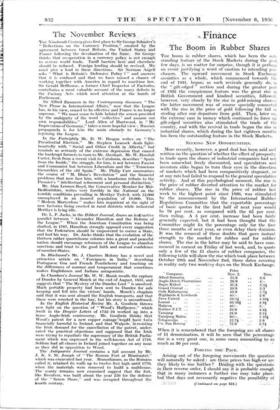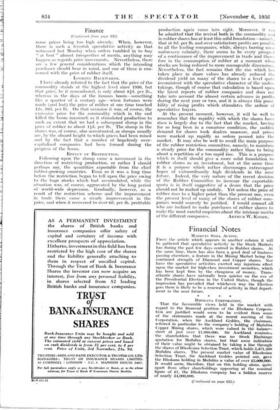The Boom in Rubber Shares
investors alike began to turn their eyes in the direction of. markets which had been comparatively stagnant, or at any rate had failed to respond to the. general speculative activity. And at this psychological moment, the rise in the price of rubber diverted attention to the market for _ rubber _shares._ The _rise An the price of rubber last Week to the highest point since 1930, was stimulated by the announcement by the International Rubber Regulations Committee that the exportable percentage of 'basic quotai for the first half of next _ year would be 70 per cent. as compared with the 65 per cent. then ruling. A 5 per cent. increase had been fairly generally expected, but it had been thought that the Committee might fix the percentage only for the first three months of next year, or even delay their decision. It was the removal of these doubts that gave instant strength to . the market for rubber and for rubber shares. The rise in the latter may be said to have com- menced in earnest on Friday of last week, and, to quote only a few of the £1 shares of rubber companies,. the following table wilt show the rise which took place between October 29th and November 2nd, those dates covering in reality only two working days on the Stock Exchange.
Price • • Company. Nov. 2. Rise.
Allied Sumatra .. 21/6 3/6 Anglo-Dutch Plantations 28/9 . 4/- Bajoe Kidoel .. .. 31/3 . 3/1} Grand Central .. .. 20/9 . 3/3 Gula Kalumpong .. 43/9 5/7* Highlands & Lowlands 40f- 3/6 Java United .. .. , 23/1f 5/10k Lumut .. .. .. 36/10k 4/41 Malacca . .. 40/-
5/-
Rubber P.I.T. .. .. 39/6 4/41- Tamiang .. .. - 28/9 3/1k • Taridjong Malim .. : 30/- 1/10k Telogoredjo .. .. .- 22/71 316 .
L'n. Sua Betong' .' . 72/6 5/7k
When it is remembered that the foregoing are all shares of £1 denomination, it will be seen that the percentage rise is a very great one, in some cases amounting to as much as 80 per cent. 1
: .
FORCING THE: FACE. • .
Arising out of the foregoing movements _the question will .naturally -be asked : are these prices too -high-or are they likely to rise further? Deming_ with the questiOns intheir reverse Order, I should say it is probable enough thit in many instances a further rise may take place, but that doxs not necessarily negative the possibility of (Continued on page 834.) THE boom in rubber shares, which has been the out- standing feature of _the Stock Markets during the past few days; is no matter for -surprise, though it is perhaps an event justifying 'a word of caution to intending pur- chasers. The upward movement in Stock Exchange securities as a whOle, which commenced towards the end of 1931; began i as such revivals generally do, in the 't gilt-edged " section and during the greater part of_ 1932. the conspicuous _feature was the great rise in British Government and kindred • securities, followed, however, very closely bithe.rise in gold-mining shares; the latter movement, was of course specially .connected with the rise in the price of gold following the fall in sterling after oni.departure from gold. Then, later on, the extreme ease in money which. continued to force up gilt-edged -Securities -also- stimulated the trade of the country, and With the-revival trade began the rise in industrial shares, which during the last eighteen months has been the outstanding feature in the Stock Markets.
• • SEEKING NEW OPPORTUNITIES. ._- . More recently, however, a good deal has.been said and written on the qtieSticin of 'whether the effect of prosperity in trade upon the shares of industrial companies had not been somewhat freely discounted, and speculators and
Finance
(Continued from page 832) some prices being too• high already. When, however, there is such a feverish speculative 'activity as that witnessed last Monday when orders tumbled in to buy " at best " almost irrespective of merits, anything may happen as regards price movements. Nevertheless, there arc a few general considerations sihich the intending purchaser should bear in mind, and one of these is con- cerned with the price of rubber itself.
LOOKING BACKWARDS.
I have already referred to the fact that the price of the commodity stands at the highest level since 1930, but that price, be it remembered, is only about 80. per lb., whereas in the days of the famous boom—something like a quarter of a century ago—when fortunes were made (and lost) the price of rubber at one time touched ]2s. 10d. per lb. On that occasion it was, of course, the excessive price for the commodity which in the end killed the boom inasmuch as it stimulated production to such an extent that we had a subsequent slump in the price of rubber to about lid. per lb.' The slump in the shares was, of course, also accentuated, as slumps usually are, by the absurd height to which prices had been raised and by the fact that a number of hopelessly over- capitalised companies had been formed during the progress of the boom.
• EFFECT OF RESTRICTION%
Following upon the slump came a movement in the direction of restricting production, or rather I should perhaps say, the quantities exportable from the chief rubber-growing countries. Even so it was a long time before the restriction began to tell upon the price owing to the huge stocks which had accumulated, while the situation was, of course, aggravated by the long period of world-wide depression. Gradually, however, as a result of the restriction scheme and the improvement in trade there came a steady improvement in the price, and when it recovered to over 6d. per lb. profitable production again came into . sight. Moreover, it can be admitted that the revival both in the commodity and in rubber shares has at least this solid foundation—namely, that at 8d. per lb. and over satisfactory profits are possible to all the leading companies, while, always barring sonic unforeseen calamity, there seems to be every prospect of a continuance of the improvement -in trade and there- fore in the consumption of rubber at a moment when stocks are being reduced to more manageable dimensions. Nevertheless, the fact remains that the rise which has taken place in share values has already reduced the dividend yield on many of the shares to a level quite inconsistent with the speculative character of the under- takings, though of course that calculation is based upon the latest reports of rubber companies and does not take into account the almost certain advance in profits during the next year or two, and it is always this possi- bility of rising profits which stimulates the ardour of speculative buyers. At the present moment, however, it will be well to remember that the rapidity with which the shares have risen is largely due to the fact that the market, having for so long been in a comatose condition, the sudden demand for shares took dealers unaware, and prices were marked up rapidly as orders poured into the market. It may also be well to recall the main purpose of the rubber restriction committee, namely, to maintain a steady price for the commodity rather than to bring about a repetition of a too rapid rise. This is a purpose which in itself should give a more solid foundation to rubber shares as an investment, but at the same time it is a purpose which rather discourages extravagant hopes of extraordinarily high dividends in the near future. Indeed, the very nature of the recent decision of the Rubber Committee to increase the exportable quota is in itself suggestive of a desire that the price should not be rushed up unduly. Yet unless the price of rubber rises to a higher point than -the present-one, even the present level of many of the shares of rubber com- panies would scarcely be justified. I would 'counsel all who are inclined to make purchases of rubber shares to make the most careful enquiries about the intrinsic merits















































 Previous page
Previous page